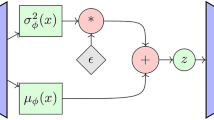Abstract
Autoencoders are regarded as one of the key functional components of deep learning architectures. In this study, we augment the well-known architectures of autoencoders by incorporating a concept of information granularity, which gives rise to so-called granular autoencoders. It is demonstrated that information granularity can be sought as an essential design asset whose optimal allocation produces the autoencoder with better representation capabilities. Several protocols of allocation of information granularity are presented and assessed with regard to their abilities to represent the data. Selected examples including those dealing with clustering time series are included.












Similar content being viewed by others
References
Al-Hmouz R, Pedrycz W, Balamash A, Morfeq A (2015) Description and classification of granular time series. Soft Comput 19:1003–1017
Bezdek JC (1981) Pattern recognition with fuzzy objective function algorithms. Plenum Press, New York
Bratton D, Kennedy J (2007) Defining a standard for particle swarm optimization. In: Proceedings of the 2007 IEEE swarm intelligence symposium, Honolulu, Hawaii, April 2007
Cano C, Adarve L, López J, Blanco A (2007) Possibilistic approach for biclustering microarray data. Comput Biol Med 37(10):1426–1436
Deng J, Zhang Z, Eyben F, Schuller B (2014) Autoencoder-based unsupervised domain adaptation for speech emotion recognition. IEEE Signal Process Lett 21:1068–1072
Gacek A, Pedrycz W (2015) Clustering granular data and their characterization with information granules of higher type. IEEE Trans Fuzzy Syst 23(4):850–860
Gao S, Zhang Y, Jia K, Lu J, Zhang Y (2015) Single sample face recognition via learning deep supervised autoencoders. IEEE Trans Inf Forens Secur 10:2108–2118
Guo Q, Jia J, Shen G, Zhang L, Cai L, Yi Z (2016) Learning robust uniform features for cross-media social data by using cross autoencoders. Knowl Based Syst 102:64–75
Kennedy J, Eberhart RC (1995) Particle swarm optimization. In: Proceedings of the IEEE international conference on neural networks, pp 1942–1948
LeCun Y, Bengio Y (1995) Convolutional networks for images, speech, and time series. In: The handbook of brain theory and neural networks, vol 336, no 100, pp 1–14
LeCun Y, Bengio Y, Hinton G (2015) Deep learning. Nature 521(7553):436–444
Leng J, Chen Q, Mao N, Jiang P (2018) Combining granular computing technique with deep learning for service planning under social manufacturing contexts. Knowl Based Syst 143:295–306
Pedrycz W (2013) Granular computing: analysis and design of intelligent systems. CRC Press/Francis Taylor, Boca Raton
Pedrycz W, Gomide F (2007) Fuzzy systems engineering: toward human–centric computing. Wiley, Hoboken
Pedrycz W, Homenda W (2013) Building the fundamentals of granular computing: a principle of justifiable granularity. Appl Soft Comput 13(10):4209–4218
Pedrycz W, Al-Hmouz R, Morfeq A, Balamash A (2013) The design of free structure granular mappings: the use of the principle of justifiable granularity. IEEE Trans Cybern 43(6):2105–2113
Pontes B, Giráldez R, Aguilar-Ruiz JS (2015) Biclustering on expression data: a review. J Biomed Inf 57:163–180
Salakhutdinov R, Hinton G (2012) An efficient learning procedure for deep Boltzmann machines. Neural Comput 24:1967–2006
Schmidhuber J (2015) Deep learning in neural networks: an overview. Neural Netw 61:85–117
van den Bergh F, Engelbrecht AP (2006) A study of particle swarm optimization particle trajectories. Inf Sci 176(8):937–971
Vu D, Aitkin M (2015) Variational algorithms for biclustering models. Comput Stat Data Anal 89:12–24
Xia C, Qi F, Shi G (2016) Bottom-up visual saliency estimation with deep autoencoder-based sparse reconstruction. IEEE Trans Neural Netw Learn Syst 27:1227–1240
Zadeh LA (1997) Towards a theory of fuzzy information granulation and its centrality in human reasoning and fuzzy logic. Fuzzy Sets Syst 90(2):111–117
Acknowledgments
This project was funded by the Deanship of Scientific Research (DSR) at King Abdulaziz University, Jeddah, under grant no. (KEP-5-135-39). The authors, therefore, acknowledge with thanks DSR technical and financial support.
Author information
Authors and Affiliations
Corresponding author
Ethics declarations
Conflict of interest
The authors declare that they have no conflict of interest.
Ethical approval
This article does not contain any studies with human participants performed by any of the authors.
Informed consent
Informed consent was obtained from all individual participants included in the study.
Additional information
Communicated by A. Di Nola.
Publisher's Note
Springer Nature remains neutral with regard to jurisdictional claims in published maps and institutional affiliations.
Rights and permissions
About this article
Cite this article
Pedrycz, W., Al-Hmouz, R., Balamash, A. et al. Granular autoencoders: concepts and design. Soft Comput 23, 9869–9880 (2019). https://doi.org/10.1007/s00500-019-03916-5
Published:
Issue Date:
DOI: https://doi.org/10.1007/s00500-019-03916-5




